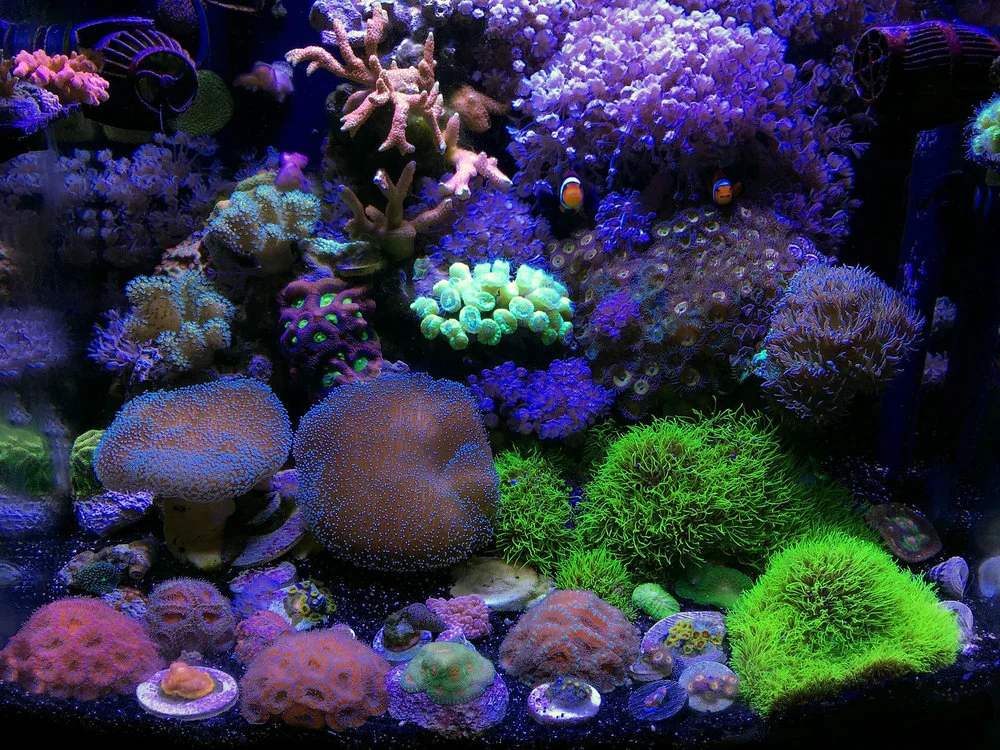Stunning 29-Gallon Reef Tank – Narzyzz_12's TOTM | NanoReef

Tank Specifications
Volume: 29 Gallons / 109 Liters
Dimensions (L × W × H):
22.4" ×
24.4" ×
20.6"
56.7cm ×
61.9cm ×
52.7cm
Equipment List
- Salt: Instant Ocean
Frequently Asked Questions
How often should I perform water changes in my reef tank?
It's recommended to perform water changes weekly, especially in smaller tanks like a 29-gallon nano reef. This helps to maintain stable water parameters and remove toxins.
What is the best way to top off evaporated water?
Use RO/DI freshwater to top off your tank. Check the water level daily and add enough freshwater to compensate for evaporation. It's important to use RO/DI water to prevent adding unwanted impurities.
How do I effectively feed my fish in a reef tank?
Feed your fish a mix of high-quality foods such as New Life Spectrum Marine Fish Formula and Hikari Mysis. Aim for two small feedings per day, ensuring not to overfeed.
What should I do if I notice algae growth in my tank?
If you notice algae, regularly test your water for nutrient levels, and perform water changes. Manually remove algae during water changes and consider introducing herbivorous fish or invertebrates that consume algae.
How can I ensure stable water parameters in my reef tank?
Regularly test your water for alkalinity, calcium, magnesium, nitrate, and phosphate levels. Based on your readings, adjust your dosing and water change schedule to maintain stability.
What is the best way to clean my tank during maintenance?
During maintenance, use a siphon to remove waste and detritus from the substrate and rocks. Manually scrub any algae off the rocks and glass. Always ensure your equipment is functioning correctly, and consider changing filter media as needed.
What type of lighting is best for a reef tank?
For a reef tank, LED lights like the AI Hydra 52 HD are excellent. They offer customizable spectrums ideal for coral growth and coloration. Additionally, actinic strips can enhance color visibility and stimulate coral growth.
How do I choose the right filtration for my reef tank?
Effective filtration is crucial. Use a combination of filter floss, activated carbon, and a skimmer to keep the water clean. Regularly change your filter media based on your tank’s bioload.
What heater should I use for my reef tank?
A reliable heater is essential. A heater like the Neotherm 100W is suitable for a 29-gallon tank, maintaining a stable temperature between 76°F - 78°F.
How can I control temperature fluctuations in my tank?
Maintaining a stable temperature can be achieved with a quality heater and considering a chiller for hot weather. Monitor the temperature closely, especially during seasonal changes.
Is it necessary to use a chiller in a reef tank?
While it's not always necessary, a chiller can help control temperatures during hot weather or prevent overheating caused by lighting. It's especially useful in smaller tanks where temperature can fluctuate more easily.
How do I properly dose supplements in my reef tank?
Start with manual dosing of alkalinity and calcium supplements, adjusting based on your water tests. Always follow manufacturer guidelines and avoid over-dosing, which can harm your corals.
How can I promote healthy coral growth in my reef tank?
To promote coral growth, maintain stable water parameters, provide adequate light and flow, and regularly feed corals with specialized foods or supplements.
What precautions should I take when adding new fish to my tank?
Always quarantine new fish before adding them to your tank to avoid introducing diseases. Also, ensure that your tank is adequately sized and that the new fish are compatible with existing inhabitants.
What type of corals are suitable for beginners in a reef tank?
Beginner-friendly corals include soft corals like Zoanthids, Xenia, and Leather corals, which are more forgiving and can thrive in various conditions.
How do I identify and deal with pest outbreaks in corals?
Identify pests such as flatworms or nudibranchs by regularly inspecting corals. Remove pests manually if possible, or use treatments specifically designed to target the pests without harming corals.